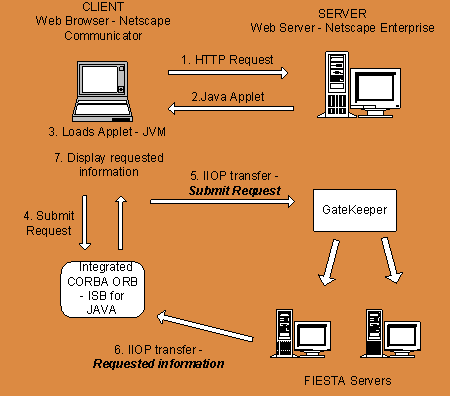|
SALSA Inc. presents: FIESTA |
|
| Project Proposal |
|
|
FIESTA
– A Distributed Entertainment System from Salsa Inc. |
||
| Abstract | ||
| A distributed entertainment resource reservation and purchase system that provides customers a familiar web based interface is described in this proposal. Salsa Inc. is proposing to develop a product called FIESTA (First Interactive Entertainment System Totally Available) that will be available on the Internet for users to reserve and purchase entertainment services like restaurants, theatre, and sporting events. FIESTA will use the Common Object Request Broker Architecture (CORBA) as the infrastructure for distributed objects and the Internet Inter-ORB Protocol (IIOP) for communication between the clients and the distributed objects. The entertainment service will be fault tolerant, highly available and secure. | ||
| Introduction Distributed object technology coupled with powerful communications infrastructure enables the development of distributed applications that can interoperate across disparate networks and operating systems. Salsa Inc. with its FIESTA product is proposing to develop such a distributed service that entertainment service providers like restaurants, theatres, sporting events can register with and customers using a familiar web interface can reserve and purchase the offered entertainment services. Since 1989, the Object Management Group (OMG), a consortium of platform vendors, ISVs and end users have been specifying the architecture for an open software bus on which objects written by different vendors can interoperate across networks and operating systems. The OMG group has specified the Common Object Request Broker Architecture (CORBA) that describes a software bus called an Object Request Broker (ORB), that provides the infrastructure for distributed object computing. The CORBA specification also includes a protocol for ORB interoperability called the Internet Inter-ORB Protocol (IIOP). IIOP is robust, scalable and transaction oriented, and runs on top of TCP/IP, the dominant protocol used by the Internet. FIESTA uses the CORBA and IIOP technologies. CORBA provides a number of benefits. It is an open solution based on a published specification. It is implemented and supported on a wide variety of hardware and operating system platforms. A COBRA software object has a defined interface. All communications go through that interface. The object can change without affecting other objects as long as the object’s interface remains the same. The CORBA objects communicate using IIOP an are fully interoperable even if different vendors develop them. System Architecture Fig. #1:
FIESTA System Architecture
Figure #1 is the architecture for FIESTA. FIESTA consists of the following modules: the Front-End Client and the Web Server, the Gatekeeper, FIESTA Servers, Administrator Module, the Back-End Consistency Server and the Service Client (Service Provider Adapters and Databases). The remaining of the proposal describes each module in brief. Front-End Client – Web Server A Front-End Client is any user that accesses the FIESTA Web Server in order to engage in a permissible transaction such as making restaurant reservations, viewing restaurant/theatre information (menu, type of cuisine, location) and purchasing theatre tickets. The back-end modules (FIESTA Servers and Service Client Databases) handle the details of the transaction. As shown in Fig. #2, the information flow between the front-end modules (Client and the Web Server) is as follows:
Fig. #2: Front-End Client – Web Server
Gatekeeper As described in the previous paragraph the gatekeeper primarily performs the load balancing function. For the first version of FIESTA, the gatekeeper will perform a very simple load balancing function that will distribute the front-end client requests to the FIESTA servers in a round-robin manner. FIESTA Servers Each instance of FIESTA server is associated with an individual client. The process is done at the FIESTA Server in the following order:
Administrator The Administrator consists of several modules: the Naming Server, the Service Catalog, and the System Monitor. The function of each module is described as below:
Back-End Consistency Server The Back-End Consistency Server receives client’s request from the FIESTA servers, and check for consistency to ensure no conflict among multiple client requests. This is necessary especially in the case of high-demand services that require transactions to be done in first-come-first-serve basis. The Back-End Consistency Server ensures the fairness in serving the requests, while also guarantees that there is no duplicate or other incorrectness. It then passes the requests to the appropriate Service Provider Adapter. Service Client The Service Provider Adapter is the front-end of the Service Client. The adapter serves as an interface between the FIESTA system and the local service provider database. It uses ODBC approach to connect with local database so that FIESTA system will be able to serve various types of database (E.g. MSSQL, Oracle, etc.). Example The following diagram (Fig. #3) describes the information flow of a simple transaction using the FIESTA architecture: Fig. #3: Simple transaction using FIESTA
|
||
| |
||
Send comments or suggestions to jmroman@andrew.cmu.edu Site last updated 2/16/98 3:00 AM
|




